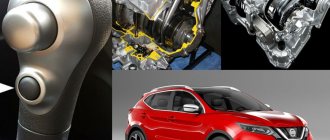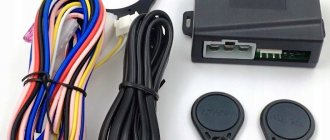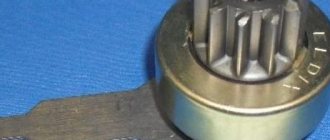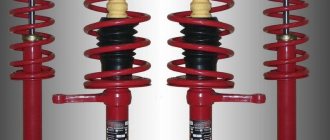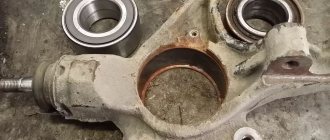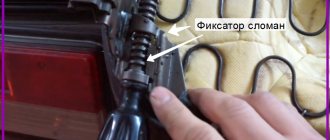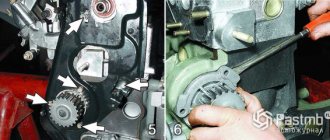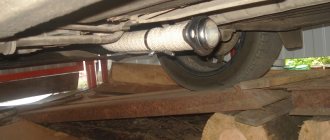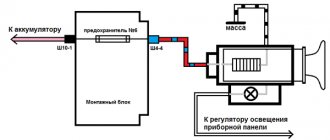The mid-size Japanese crossover Nissan Murano is represented on the car market in three generations. Powerful car engines are combined with Xtronic CVT transmission. Depending on the generation, cars are equipped with CVTs that have design differences. The units are characterized by smooth running, provide good acceleration dynamics and allow economical fuel consumption. High performance and a balance of comfort are achieved by minimizing the coefficient of friction of components and expanding the range of gear ratios.
| Crossover generation | Year of issue | Engine capacity | type of drive |
| Nissan Murano Z50 | 2002-2007 | 3.5 l | front/full |
| Nissan Murano Z51 | 2007-2016 | 2.5 l | front/full |
| Nissan Murano Z52 | since 2016 | V6 3.5 l | full |
Despite the high reliability of Xtronic CVT, they are susceptible to malfunctions, which can be eliminated by repairing the variator. Breakdowns occur mainly due to natural wear and tear with a high mileage of the crossover and a small residual working life, as well as due to illiterate operation, untimely maintenance and driving at maximum load.
CVT transmissions are technologically advanced units and if a breakdown occurs, they require qualified diagnostics and competent repairs using modern equipment. This is what the experienced craftsmen in our service specialize in.
Nissan Murano CVT models
Depending on the generation of the crossover, different models of CVTs were installed on the Nissan Murano.
| Crossover model | Engine capacity | Drive unit | CVT model |
| Nissan Murano Z50 | 3.5 l | front/full | RE0F09A (JF010E) |
| Nissan Murano Z51 | 2.5 l | front/full | JF011E |
| Nissan Murano Z52 | 3.5 l or 2.5 l | full | JF017E/ JF016E |
The JF010E model is a reinforced modification of the RE0F06A variator and was introduced by JATCO in 2002 to work with engines on the first generation Nissan Murano Z50 crossovers. This transmission is characterized by:
- Cones with increased service life thanks to special coating.
- Increased sizes of some parts.
- Installation of a vane type oil pump with a chain drive.
The technological unit is easy to operate, wear-resistant and inexpensive to repair. It is recommended to change the oil every 40-45 thousand km.
In 2005, Japanese engineers created a high-tech CVT JF011E for the second generation Nissan Murano Z51. A continuously variable transmission was also installed on models from Mitsubishi, Renault, Citroen and others. The unit was distinguished by great driving comfort, reliability and relatively low cost of components, consumables and repairs.
The design of the JF011E variator uses a Bosch pusher belt, as well as two reinforced cones for the ability to use the gearbox with engines with a power of more than 200 hp. Thanks to the elimination of certain design flaws in the previous modification, it was possible to significantly increase the reliability of the transmission. As a result, the service interval and operational life of the unit before repair were increased.
The new generation JF016E/17E variator began to be installed on the Nissan Murano Z52 in 2012. The transmission is designed to interact with engines of different power from minicar to 3.5 liters. The valve body operating algorithm has been improved. For installation on a crossover, the variator is structurally equipped with a Bosch belt, which has an increased service life before repair. For long-term trouble-free operation, maintenance of the valve body and solenoids is required.
Fuel consumption
Fuel consumption in the Nissan Murano Z51, as in any other car, depends on the engine the vehicle is equipped with, the fuel used, the type of road (highway or city), and driving style.
However, the consumption figures stated by car manufacturers apply. This table shows mixed fuel consumption data (highway + city) for the most popular modifications of the Nissan Murano Z51.
| Engine volume, l | Fuel | Consumption per 100 km, l |
| 2.5 | Gasoline AI-95 | 8,6-9,1 |
| 2.5 | Diesel fuel | 8 |
| 3.5 | Gasoline AI-95 Gasoline AI-98 | 10.6 10.9 |
It is quite possible to reduce fuel consumption a little. To do this you will need:
- carry out timely diagnostics of all machine systems;
- monitor thermostat readings;
- monitor the readings of the coolant temperature sensor;
- Fuel your car only with high-quality fuel;
- develop a calm driving style;
- brake and move off smoothly.
It is especially important to follow all these rules in winter, otherwise fuel consumption will be too high, which will naturally make driving the Nissan Murano Z51 uncomfortable.
Design and principle of operation of the Nissan Murano variator
The Nissan Murano variator is a V-belt unit and ensures the transmission of torque removed from the engine crankshaft to the drive wheels of the crossover. Structurally, the transmission includes electronic and mechanical parts. Main gearbox mechanisms:
- Basic mode control unit.
- A device that provides torque transmission and disconnection from the engine crankshaft in neutral gear.
- CVT transmission (belt, cones, couplings, conical discs).
- Unit (planetary gear) for turning on reverse.
All spare parts of the Nissan Murano variator are placed in a sealed housing into which transmission oil is poured to prevent overheating of the unit. In a continuously variable transmission, two cones (driver and driven) are connected by a metal belt. Each cone consists of conical disks, which, by moving, change its diameter. The control unit adapts the diameter of the driven and driving pulleys to the operating conditions of the unit, selecting the optimal transmission force.
As a result, the torque transmitted to the driving wheels of the car changes. Maximum engine power and good dynamic acceleration of the car are ensured. Thanks to the planetary gearbox, reverse movement is carried out using the gear selector.
The gear ratios change endlessly, so the variator does not have gears, as in a classic gearbox. The design also provides the driver with the ability to manually change gears both up and down. The optimal operating temperature of the variator is ensured by a modern cooling system.
Thermal mode
The temperature regime in CVTs should be observed especially carefully. This function is assigned to the self-diagnosis system and is carried out using a temperature sensor. If the limit value is exceeded, a fault signal lights up on the dashboard with the simultaneous transition of the variator to an emergency state.
In order to ensure optimal oil temperature, on most cars, in addition to the main heat exchanger, another radiator is connected. It is mounted in the front area of the engine compartment up to the climate system condenser. Through the air ducts located in the bumper, it is often clogged with various debris - poplar fluff, leaves, dirt, gravel, midges, etc. The first manifestation of its critical contamination is severe overheating when traveling at high speeds. Once every two years it is necessary to clean and wash it very thoroughly. It's best to have the bumper disconnected. It is also recommended to cover the external entrances of the air ducts with protective nets, since the radiator is susceptible to damage from anything that flies from under the wheels.
According to the collected statistical data, failures of variators occur no more often than failures of hydromechanical units. Even the most cautious manufacturers, who were previously quite skeptical about the reliability of CVTs, began to use them in the power units of their popular models. For example, Toyota - on the restyled RAV4, Subaru - on Forester, XV and Outback. The owners of this brand can hardly be called slow drivers. Constant driving over rough terrain and powerful accelerations were recently considered unacceptable for the operation of CVTs. It seems that times are changing, so the prospects are brighter for them.
Source
Service life of the Nissan Murano variator
The Japanese manufacturer JATCO claims the service life of the CVT transmission without repairs is 200 thousand km. In fact, if the rules for using the variator established by the manufacturer are not followed, with an aggressive driving style and poor quality maintenance, the mileage before repair may be much less than the stated period. With proper operation of the Nissan Murano CVT and timely maintenance in a specialized car service using original components and consumables, the service life until failure or before major repairs can be 250-300 thousand km.
What if you handle it with care?
This variator became the next link behind the very reliable units of the first generation (RE0F06A), which we did not see - of course, with the exception of those who brought right-hand drive cars from Japan. Its descendant, JF016, is now installed on many cars, and it is considered more capricious and unreliable.
With proper operation, the Jatco JF011 variator runs for a long time: problem-free runs of up to 180,000 km are known.
The main thing is not to overload the variator, change the working fluid every 45,000 km and contact specialists at the first sign of a malfunction. CVT repair is not a cheap operation. But usually it costs no more to repair it than a hydromechanical automatic machine.
Source
What affects the service life of a variator?
To increase the working life of the Nissan Murano variator and ensure a high reliability indicator, compliance with the operating mode of the unit is required. When driving a car with a CVT transmission, you must avoid:
- Long-term driving under high load on country roads. The variator overheats and metal shavings get into the crankcase. Mechanical destruction of parts is possible, which will entail expensive repairs.
- Slippage when driving a crossover on an icy surface, causing overheating of the unit and breakdowns.
- Drift on ice, as well as on any other surface.
- Towing a trailer. It is also prohibited to tow another vehicle. A constant load may cause the electronic control unit to malfunction and the system to jam.
- Extending service intervals. The manufacturer recommends changing the oil after 150 thousand km, but it is more advisable to perform maintenance after 60 thousand km.
When performing service or repair of the variator, our specialists use only original NS2 and NS3 gear oils recommended by the manufacturer of the continuously variable transmission. If the listed operating rules are not followed, the resource of the unit will be significantly lower than that declared by the manufacturer.
Signs of trouble
Noise and rattle
The reason is wear of the bearings on which the cones rotate. And, even worse, wear of the seats of these bearings. Both low-quality bearings and a loose fit are a manufacturing defect. Sometimes it can be fixed under warranty. If the warranty has expired, only complete disassembly and troubleshooting will save you.
You shouldn’t delay repairs for a long time: wear products spread throughout the variator and damage all its components.
Jerks during acceleration
They indicate instability of the control pressure. The pressure reducing valve is responsible for regulating the pressure created by the hydraulic pump. Metal shavings cause it to hang, and the pressure of the working fluid becomes unstable. But it controls the compression of the cones.
Switching to emergency mode
If significant deficiencies are detected, the control unit switches the variator to emergency mode. If after restarting the engine the car can be driven, then the reason is most likely a malfunction of the control electronics.
Complete immobilization of the car
A situation when the variator suddenly stops transmitting torque: the engine roars, but the car does not move. The most likely cause is a broken steel belt. Here you need to call a tow truck.
Jerks in all modes
Bearing wear and problems with the pressure reduction valve gradually damage the belt and cones - the most expensive and important elements of the variator. Belt slippage caused by scuffing on the working surfaces is manifested by twitching in all driving modes. Repair of the variator in this case consists of replacing the cones and belt. Sometimes it is possible to grind the cones, but the belt will have to be replaced in any case.
Checking the Nissan Murano variator
It is possible to check the performance and the need for repair of a variable-speed transmission (CVT) on site, as well as on the move. When parking, you need to manually shift all gears one by one. As a result, there should be no shocks or unusual sound (hum). When moving the lever (mode selector), even the slightest grinding noise should not be heard.
When driving a car, the driver can manually turn on/off all gears one by one. Also, to check you need to accelerate in different modes. In a working unit, all shifts are performed smoothly without jerking. When braking sharply, the variator should not slip.
general characteristics
Variable speed transmissions (CVT) are very popular today. They are installed in cars of different models. The presented transmission has a number of advantages. Therefore, this particular type of gearbox is installed in Nissan Murano models.
It should be noted that this brand puts three generations of cars on the market. The first model to be introduced to the market was the Z50. It was produced from 2002 to 2008. The second generation Z51 model also won worldwide recognition. This car is also in demand among Russian buyers. She debuted in 2007. Also on sale is the third generation of Nissan Murano - Z52.
Models Z50, Z51 Nissan Murano have a CVT, which is manufactured using the latest technologies. In used cars it needs repair or maintenance. Therefore, in our country, these types of lines are most often repaired. There is a wide selection of spare parts for sale for the first two generations of Murano CVTs.
Typical CVT failures
During operation of the variator, the following parts are most often susceptible to malfunctions:
- Oil pump (reducing valve).
- Cones.
- Belt variator.
- Torque converter.
In an oil pump, when using low-quality transmission lubricant, as well as due to the presence of chips from wear of parts, the pressure relief valve becomes clogged (wears out). As a result, the oil pressure in the system decreases and the variator overheats, which may require major repairs.
Dirty oil causes the belt to slip and wear out the working surface of the cones. The system has two oil filters. The fine cleaning element changes along with the oil. The second filter element installed in the pan is serviced during a major overhaul of the variator. Failure to promptly change the oil and filter will result in repair of the unit.
The belt is assembled from separate segments, which are firmly tied together with steel straps. When the tapes are damaged or broken, burrs appear on the cones. In this case, the crossover will drive with slippage. A new belt on cones with scuffs will quickly become unusable. Grinding is used to restore the surface of the pulleys.
A malfunction of the Nissan Murano variator torque converter occurs due to oil starvation and low pressure, as well as severe wear of the motor that regulates the position of the belt. Due to breaks, the belt stretches and breaks. Complete destruction of the belt will lead to expensive repairs of other parts.
CVT service life
According to official data, the service life of the CVT transmission coincides with the service life of the Nissan Murano. That is, the manufacturer expects that the variator will not require repairs during its entire service life, which should be at least two hundred thousand kilometers. However, judging by the reviews of other motorists, the service life of the unit is not eternal.
What problems can cause a breakdown and further need for gearbox repair:
- If you want your Nissan Murano’s variator to not require periodic repairs, you should service it on time and follow basic operating rules. This will help significantly increase its service life.
- According to the vehicle manufacturer, the gearbox oil should be changed, and this should be done at least every 60 thousand kilometers. In addition, when replacing the working fluid, attention should be paid to the condition of the filters. If both or at least one of them are clogged, then the elements should be replaced.
- Certain driving conditions must be observed. When driving off-road, through snowdrifts and in other difficult operating conditions, you must drive the car carefully, without sudden acceleration.
- For those who like to skid or drift on ice, Nissan Murano cars with a CVT are not intended. To help increase component life, slippage must be eliminated. Moreover, this applies to any road surface and any weather.
- It is strictly not recommended to load your vehicle as much as possible. Forget about transporting trailers with a load capacity of more than 500 kilograms. In this case, small trailers for transporting essentials do not count.
- Despite the existence of road and driving ethics, forget about helping other people. In particular, this refers to cases when you are asked to pull a car out of a snowdrift or tow a car to a service station. Despite the fact that you have an SUV and you do not want to be insensitive towards other motorists, such actions very often cause a decrease in the life of the unit used. CVT gearboxes are very sensitive to this kind of action.
- The CVT transmission should always operate in normal mode. It should not overheat, so periodically monitor the condition of the transmission temperature sensor. If the Nissan Murano gearbox often overheats, then repairs are not far off. If this happens for the first time, we recommend that you turn off the engine and wait a while until the temperature of the unit drops to normal.
- Forget about sudden maneuvers on a cold engine. If the vehicle is not warmed up to operating temperature, do not press the gas sharply to avoid breakdowns and subsequent repairs of the unit. This is especially true during the winter period of the year. Even if you are late for work, take the time to fully warm up your vehicle. Judging by reviews from car enthusiasts, this action is a common cause of component failure.
Diagnosis of CVT Nissan Murano
To check the operation of the control unit, as well as the presence of error codes, a special scanner is used. Diagnostics are performed without disassembling the unit. The cause of breakdown, incorrect operation and the need to repair the control unit is often moisture that gets onto the electronics through a violation of the seal of the housing.
The mechanical part is checked by opening the variator. The car is raised on a lift, the transmission oil is partially drained and the crankcase is dismantled. Visual inspection identifies microcracks and mechanical damage to parts (assemblies). If defects are identified, the Nissan Murano variator is repaired.
CVT repair prices
| Service provided | Cost, rub. | Note |
| Major renovation | 10000 | Excluding components for repair |
| Montage demontage | 8000/7000 | Front/all wheel drive |
| Disassembly | 1100 | |
| Diagnostics | 1000 | Included in the cost of repairs |
| Adaptation after renovation | 900 | |
| Change of oil | 1000 | Excluding consumables |
| Tow truck | for free | If major repairs are being carried out |
CVT repair stages
Nissan Murano CVT repairs are performed by our specialists in the following sequence:
- Transmission diagnostics. The test is performed using special equipment. To determine faults, an additional test drive of the vehicle can be carried out.
- Dismantling the unit for the purpose of disassembling the housing and carrying out troubleshooting. A special lift is used to remove the unit from the machine. The opening and inspection of parts to find defects is carried out in the presence of the car owner. The master demonstrates the actual condition of the transmission components and mechanisms.
- Troubleshooting repairs. Specialists replace defective parts. Repairs are carried out in accordance with the regulations, taking into account the manufacturer’s requirements. The volume and cost of operations are agreed upon with the car owner.
- Assembly and installation of the unit on the car.
- Checking the performance of the variator. For this purpose, computer diagnostics and a test drive of the crossover are carried out to run in the unit after repair.
- Reception of the car by the owner. After checking the quality of the repair, a certificate of completion of work is signed with the owner of the car.
Installing an additional radiator
There are situations when an old or restored Nissan Murano radiator cannot cope with cooling the variator. In this case, you need to install an additional element that provides better heat dissipation.
Algorithm of actions:
- Removing the front part of the hood in front of the main radiator.
- Fastening an additional radiator using special clamps.
- Connecting tubes to the input and output.
- System testing.
How to repair a Nissan Murano variator yourself
To independently repair a Nissan Murano CVT, you need experience, knowledge of technological maps for the Nissan Murano CVT, practical skills, as well as special equipment and a lift. We strongly do not recommend doing repairs yourself, as you can cause even more damage. Let's share the basic principles of how it is implemented.
- Preparation. At the first stage, preparatory work is carried out before repairs. To dismantle and repair the unit from the car, you will need a set of keys, screwdrivers and other tools. It is also necessary to provide containers to arrange the parts in a certain sequence when disassembling the variator.
- Disassembling the variator. At the disassembly stage, it is recommended to take a photo of the gearbox so as not to make mistakes when assembling the unit. After dismantling the variator for repairs:
- The cover is removed from the housing.
The shaft is dismantled.
- The second cover is removed along with the axle.
- The oil pump is dismantled.
- The gear with the drive chain is removed.
- Continued dismantling of CVT components. To replace faulty parts and repair components, you need to dismantle the remaining components of the unit:
- Oil pump cover.
- Pulley.
- The cover on the back of the variator.
- Belt and shafts.
- CVT repair and assembly. After complete disassembly, defective (worn) parts are identified. You also need to check the size of the gaps according to the technical documentation. Faulty components are being replaced. Reassembling the transmission after repair is performed in the reverse order.
When independently repairing a Nissan Murano variator, it is important to follow the sequence of disassembling and reassembling a complex unit. Therefore, it is advisable to entrust the repair of the Nissan Murano variator transmission (CVT) to the professional craftsmen of our company, who thoroughly know the design and operating principle of the unit. When contacting our specialists for transmission repair:
- Saves time searching for quality parts.
- Restoring the unit's functionality will cost less than repairing it yourself.
- The correct execution of all operations is guaranteed.
What spare parts may be needed for repairs?
| Name of spare parts | price, rub. |
| Belt | from 25 000 |
| Pump | from 18 000 |
| Restoring cones | from 7 500 |
| Set of rubberized pistons | from 6 000 |
| Bearing kit | from 4 000 |
| Repair kit (set of gaskets and seals) | from 10 000 |
| Filter - cartridge | from 700 |
| Prices vary depending on the make and year of manufacture of the car, check with the manager. |


